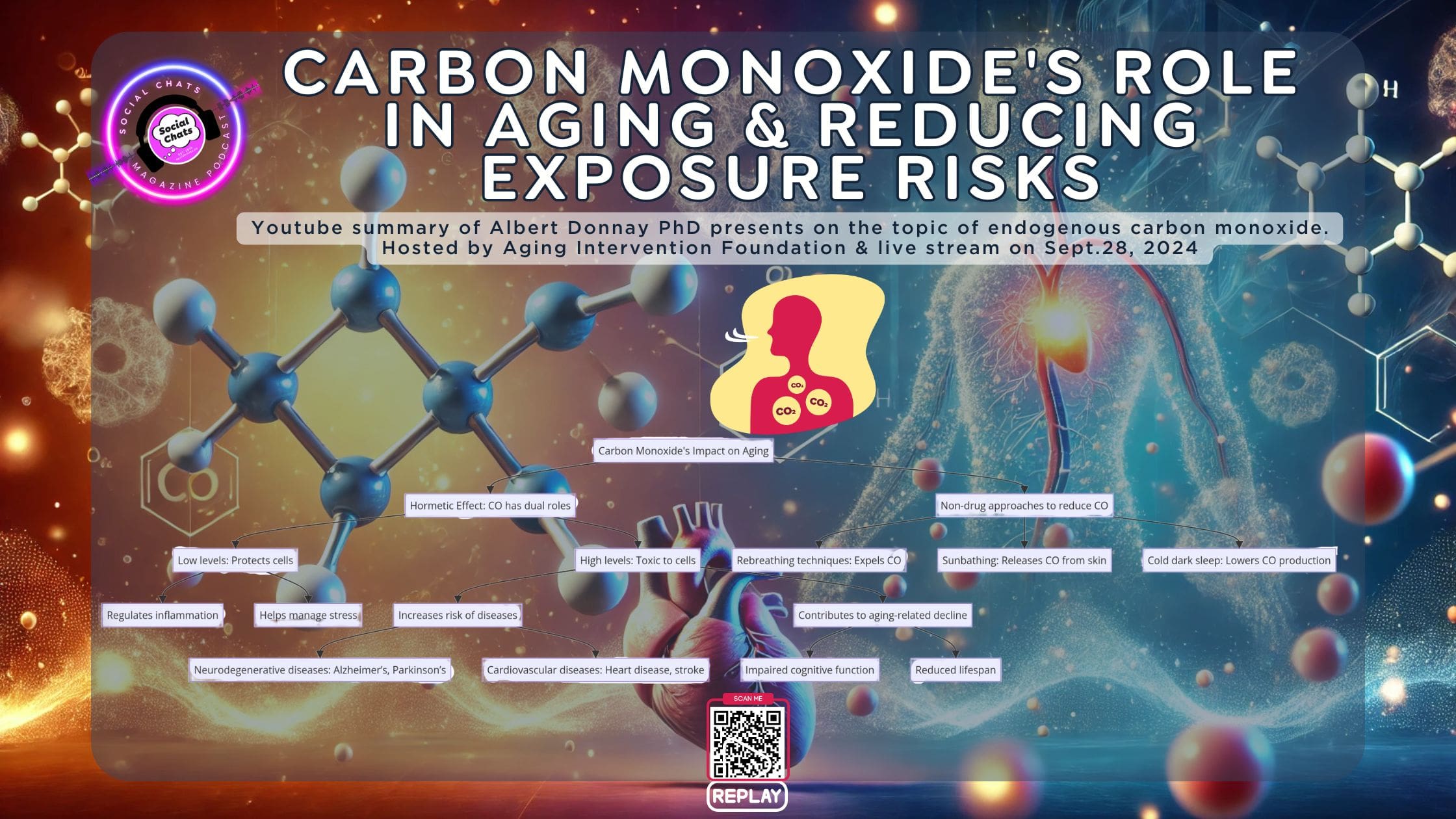

Carbon monoxide (CO) is a silent but powerful force that affects our health in ways we might not expect. Hosted by Aging Intervention Foundation, on September 28, 2024, Albert Donnay PhD delivered a comprehensive presentation how both endogenous (internally produced) and exogenous (externally introduced) carbon monoxide influences aging, disease, and death. This groundbreaking research dives into the dual nature of CO in our bodies and how even low-level exposure can dramatically impact our health. But there’s hope—Donnay also shares actionable steps to help reduce carbon monoxide’s harmful effects and slow the aging process.
As we age, understanding the role of carbon monoxide becomes increasingly critical. According to Donnay, CO levels in our bodies act as a double-edged sword. In small doses, CO can actually protect cells by promoting stress responses and inflammation control. But over time, an accumulation of carbon monoxide—whether produced naturally or through environmental exposure—can lead to chronic conditions like heart disease, cognitive decline, and stroke. His research presents CO as a “hormetic agent,” meaning it can either promote health or trigger illness, depending on how much is present. This makes managing CO levels crucial for maintaining long-term wellness.
Watch the full presentation by Albert Donnay PhD:
Albert Donnay PhD presents on the topic of endogenous carbon monoxide
Time Interval: 00:00 to 105:00
Summary
Albert Donnay presents the complex role of carbon monoxide in human biology, focusing on its effects on aging, cognitive health, and disease progression. His lecture details the concept of carbon monoxide as a hormetic agent, meaning that in small amounts it can be protective, while large amounts are toxic. Donnay explains how men and women differ in their regulation of CO, how environmental exposure plays a significant role in health outcomes, and practical, non-drug methods to manage carbon monoxide levels for improved longevity.
Key Takeaways:
- 🧪 Role of Carbon Monoxide in Aging, Disease, and Death: Albert Donnay discusses the impact of endogenous carbon monoxide (CO) in biological processes, such as aging and disease, explaining that CO plays a dual role, both protective and harmful depending on its levels.
- 🔬 CO as a Hormetic Agent: CO exhibits hormetic effects, meaning small amounts can be beneficial, while large amounts are toxic, which aligns with how organisms manage stress responses.
- 🧠 Impact on Cognitive Health: Chronic exposure to low levels of CO is linked to diseases such as Alzheimer’s and Parkinson’s. CO can accumulate in tissues, impairing organ function.
- 🏥 Health Disorders Linked to CO: CO poisoning, both from external sources (like pollution) and internal production, has been associated with conditions like heart disease, stroke, and even mortality increases in the elderly.
- 📉 Reduced Aging Methods Without Drugs: Donnay suggests alternative aging reversal techniques, such as avoiding overuse of supplements, reducing external CO exposure, and non-drug interventions like controlled breathing exercises to manage CO levels.
- 🌡️ Environmental and Lifestyle Triggers: He highlights environmental factors such as heat, pollution, and certain medical treatments that can increase endogenous CO production, thus influencing health and aging.
The Dual Role of Carbon Monoxide in Aging and Health
One of the key points Donnay emphasizes is the hormetic effect of carbon monoxide on health and aging. Small amounts of CO can stimulate positive biological responses, such as the regulation of stress and aging, while large amounts can overwhelm the body, leading to harmful consequences.
Environmental and Lifestyle Triggers of CO Accumulation
Environmental CO exposure from pollution, gas appliances, and even activities like sunbathing or rebreathing techniques play a role in increasing CO levels in our bodies. While brief, controlled sun exposure can help release CO stored in skin tissues, excessive heat or sweating leads to an increase in CO production, underscoring the delicate balance between beneficial and harmful exposure.
Rebreathing methods, like cupping your hands over your nose and mouth, help increase oxygen intake and expel built-up CO. These methods align with Donnay’s belief in non-invasive approaches to aging that avoid the use of drugs or supplements.
Key Insights from Donnay’s Research on Carbon Monoxide
- CO’s Link to Cognitive Decline: Donnay draws a direct line between long-term, low-level CO exposure and neurodegenerative diseases like Alzheimer’s and Parkinson’s. As CO accumulates in tissues, it disrupts oxygen delivery to brain cells, leading to cell death and impaired cognitive function.
- Gender Differences in CO Levels: Interestingly, Donnay explains how men and women handle CO differently. Women’s natural hormonal cycles, particularly the menstrual cycle, allow them to manage CO levels more effectively than men. This, he suggests, could contribute to the longer average lifespan of women.
- Impact on Cardiovascular Health: Chronic exposure to CO increases the risk of heart disease and stroke, especially in the elderly. As CO builds up over time, it puts stress on the cardiovascular system, further accelerating aging.
Simple, Effective Strategies to Reduce Carbon Monoxide Exposure
Managing CO levels doesn’t require complex treatments or pharmaceuticals. According to Donnay, small lifestyle changes can go a long way in reducing CO accumulation and promoting healthy aging:
- Controlled Sun Exposure: Sunlight helps release CO stored in skin tissues, but it’s important to avoid overheating, which can cause CO production to spike. Sunbathe in the morning or late afternoon to avoid excess heat.
- Rebreathing Techniques: These simple breathing exercises can help increase oxygen intake and naturally expel CO from the body, making it an effective, drug-free approach.
- Cold, Dark Sleep Environment: Sleeping in a cool, dark room helps minimize CO production, as it reduces exposure to light and heat, both of which can stimulate endogenous CO production.
Why This Matters for Your Health and Longevity
Donnay’s research shows that we all accumulate carbon monoxide over time, whether from environmental exposure or natural production within our bodies. This makes controlling CO levels crucial for living a longer, healthier life. If left unmanaged, CO build-up can accelerate aging, increase vulnerability to chronic diseases, and reduce overall life expectancy.
Conclusion Diagram
Here is the visual representation of carbon monoxide’s impact on aging and health as presented by Albert Donnay:

Insights Based on Numbers
- 🧮 190+ CO-related conditions: The video highlights over 190 conditions caused by high-level CO exposure, showcasing its vast potential for health issues.
- 📊 50% higher death rate: Exposure to even slight increases in CO (e.g., from 0.5 to 2 PPM) can increase mortality in specific populations, such as those with glioblastoma, by up to 50%.
- 🧑⚕️ 220,000 annual CO-related ER visits: CO poisoning contributes significantly to emergency room visits, far exceeding initial estimates of 15,000.
Timestamps:
Relevant timestamps for key points from Albert Donnay PhD’s presentation on carbon monoxide and its impact on health and aging:
- Introduction and overview of the session: 00:00
- Tribute to Steve Perry and initial discussions: 00:31
- Introduction of Albert Donnay and his research: 01:05
- The role of endogenous carbon monoxide in aging: 01:36
- CO’s hormetic effect and its implications: 02:37
- Five methods to slow carboxy-aging: 03:38
- Background on Donnay’s toxicology research: 04:10
- CO and its connection to neurodegenerative diseases: 05:14
- The connection between CO and Edgar Allan Poe’s illness: 05:44
- Conditions associated with CO exposure: 06:16
- Measuring CO levels and health impacts: 07:19
- CDC guidelines on CO poisoning: 07:49
- Environmental CO exposure: 08:53
- Link between CO exposure and elderly health: 09:55
- Mortality rates and CO exposure: 10:27
- Sunlight and CO release from skin: 10:59
- CO levels in the brain and aging: 12:32
- How to manage CO exposure safely: 14:10
- Differences between men and women in CO regulation: 14:41
- Practical advice on controlling CO levels: 16:48
These timestamps provide a guide to the most important topics and discussions covered during the presentation.

Q&A
- How does endogenous CO affect the aging process differently in men and women?
Albert Donnay explains that men and women experience different rates of CO accumulation due to factors such as body size, blood volume, and hormone cycles. Key points include:
- Men’s Higher Initial CO Levels: Men generally have higher endogenous CO levels because of their larger body size, greater blood volume, and more hemoglobin. This trend starts in puberty and continues throughout life. As men age, their CO levels begin to decline, particularly after andropause.
- Women’s Steady CO Levels: Women’s CO levels remain relatively steady throughout life, even after menopause. The reason for this stability is tied to their menstrual cycles, where CO levels rise and fall naturally due to the breakdown of the endometrial layer. This periodic fluctuation helps women avoid continuous CO accumulation, contributing to their longer average lifespan compared to men.
- Hormonal Impact: Estrogen in women helps modulate CO levels and stress responses, maintaining a balance that men tend to lose as they age. Men, on the other hand, see a more pronounced decline in their CO production capacity after middle age, weakening their ability to manage stress through this mechanism.
In conclusion, women’s cyclical CO management via their reproductive systems may contribute to their longevity, while men accumulate CO more steadily, with a late-life decline in CO regulation contributing to aging-related vulnerabilities.
2. What are the long-term risks of environmental CO exposure on cognitive health?
Albert Donnay highlights the significant risks posed by long-term exposure to low levels of environmental carbon monoxide (CO), particularly regarding cognitive health. Key points include:
- Chronic Low-Level CO Exposure: Long-term exposure to even slightly elevated CO levels in the environment—such as from vehicle exhaust, household appliances, or smoking—can accumulate in the body over time. This low-level exposure may not cause immediate symptoms but can lead to a gradual decline in cognitive and neurological health.
- Link to Neurodegenerative Diseases: Donnay connects chronic CO exposure to a higher risk of developing neurodegenerative diseases such as Alzheimer’s, Parkinson’s, and dementia. The accumulation of CO in the brain can impair oxygen delivery to neurons and other brain cells, leading to cell death, memory loss, and overall cognitive decline.
- Impact on Elderly Populations: The elderly, especially those with pre-existing conditions like cardiovascular diseases or respiratory issues, are at heightened risk. Their ability to process and expel CO diminishes with age, which can accelerate cognitive decline and increase the likelihood of conditions like stroke, making long-term CO exposure particularly harmful.
In summary, continuous low-level CO exposure presents long-term cognitive health risks, contributing to diseases like Alzheimer’s and increasing mortality in the elderly. This highlights the importance of managing and mitigating CO exposure to protect brain health.
3. How do alternative methods like rebreathing or sunbathing influence CO levels in the body?
Albert Donnay discusses how alternative non-drug methods such as rebreathing and sunbathing can influence carbon monoxide (CO) levels in the body, offering ways to regulate or reduce its impact:
- Rebreathing Techniques: Donnay mentions that controlled rebreathing exercises, such as cupping your hands over your nose and mouth to rebreathe your exhaled air, can help increase oxygen intake and promote the expulsion of CO from the body. This method mimics natural breathing processes and accelerates the removal of accumulated CO, especially for those exposed to external sources.
- Sunbathing: Sunlight can help release CO bound in skin tissues. When exposed to light but without overheating (i.e., avoiding sweating), sunbathing allows CO to be exhaled from the hem proteins in the skin. However, overheating and excessive sweating can induce the production of more endogenous CO, so the balance between heat and light exposure is important.
- Cold Darkness: Another method Donnay suggests is sleeping in a dark, cold room, which minimizes the production of CO by limiting exposure to heat, light, and other external inducers. This approach helps the body maintain lower endogenous CO levels naturally.
These methods are positioned as natural, non-invasive ways to regulate CO levels, without the need for medications or supplements, and provide a balanced way to manage CO’s effects on the body.
As Albert Donnay states, “Carbon monoxide is both our friend and our foe—it’s how we manage it that determines whether it prolongs life or speeds up aging.” Understanding the impact of carbon monoxide on our bodies empowers us to make healthier choices and take control of our aging process.
Ready to take the next step in managing your carbon monoxide exposure? Start today by implementing these simple techniques, and discover the benefits of CO control in promoting long-term health and wellness. For more insights on CO and aging, check out Donnay’s full presentation here.
*Disclaimer: This summary/ long form blog was created with the assistance of AI language model ChatGPT by OpenAI.
WRITTEN BY
Social Chats
Social Chats is a multimedia and entertainment company. It’s a division of kNOw Aging, inc. a communications consultancy.









